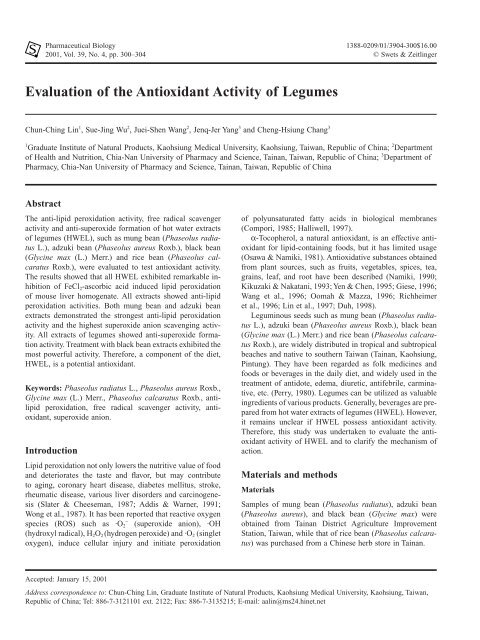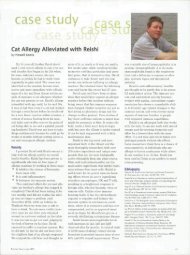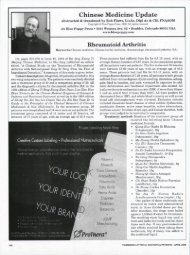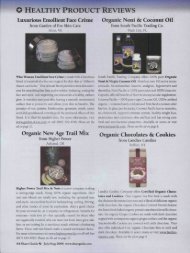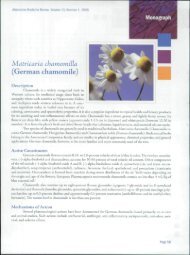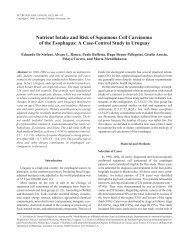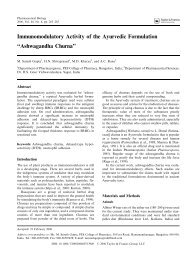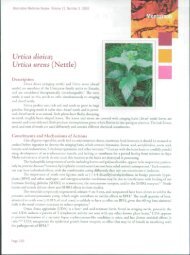PDF (51 KB) - Informa Healthcare
PDF (51 KB) - Informa Healthcare
PDF (51 KB) - Informa Healthcare
You also want an ePaper? Increase the reach of your titles
YUMPU automatically turns print PDFs into web optimized ePapers that Google loves.
Pharmaceutical Biology 1388-0209/01/3904-300$16.00<br />
2001, Vol. 39, No. 4, pp. 300–304 © Swets & Zeitlinger<br />
Evaluation of the Antioxidant Activity of Legumes<br />
Chun-Ching Lin 1 , Sue-Jing Wu 2 , Juei-Shen Wang 2 , Jenq-Jer Yang 3 and Cheng-Hsiung Chang 3<br />
1<br />
Graduate Institute of Natural Products, Kaohsiung Medical University, Kaohsiung, Taiwan, Republic of China; 2 Department<br />
of Health and Nutrition, Chia-Nan University of Pharmacy and Science, Tainan, Taiwan, Republic of China; 3 Department of<br />
Pharmacy, Chia-Nan University of Pharmacy and Science, Tainan, Taiwan, Republic of China<br />
Abstract<br />
The anti-lipid peroxidation activity, free radical scavenger<br />
activity and anti-superoxide formation of hot water extracts<br />
of legumes (HWEL), such as mung bean (Phaseolus radiatus<br />
L.), adzuki bean (Phaseolus aureus Roxb.), black bean<br />
(Glycine max (L.) Merr.) and rice bean (Phaseolus calcaratus<br />
Roxb.), were evaluated to test antioxidant activity.<br />
The results showed that all HWEL exhibited remarkable inhibition<br />
of FeCl 2 -ascorbic acid induced lipid peroxidation<br />
of mouse liver homogenate. All extracts showed anti-lipid<br />
peroxidation activities. Both mung bean and adzuki bean<br />
extracts demonstrated the strongest anti-lipid peroxidation<br />
activity and the highest superoxide anion scavenging activity.<br />
All extracts of legumes showed anti-superoxide formation<br />
activity. Treatment with black bean extracts exhibited the<br />
most powerful activity. Therefore, a component of the diet,<br />
HWEL, is a potential antioxidant.<br />
Keywords: Phaseolus radiatus L., Phaseolus aureus Roxb.,<br />
Glycine max (L.) Merr., Phaseolus calcaratus Roxb., antilipid<br />
peroxidation, free radical scavenger activity, antioxidant,<br />
superoxide anion.<br />
Introduction<br />
Lipid peroxidation not only lowers the nutritive value of food<br />
and deteriorates the taste and flavor, but may contribute<br />
to aging, coronary heart disease, diabetes mellitus, stroke,<br />
rheumatic disease, various liver disorders and carcinogenesis<br />
(Slater & Cheeseman, 1987; Addis & Warner, 1991;<br />
Wong et al., 1987). It has been reported that reactive oxygen<br />
-<br />
species (ROS) such as ·O 2 (superoxide anion), ·OH<br />
(hydroxyl radical), H 2 O 2 (hydrogen peroxide) and ·O 2 (singlet<br />
oxygen), induce cellular injury and initiate peroxidation<br />
of polyunsaturated fatty acids in biological membranes<br />
(Compori, 1985; Halliwell, 1997).<br />
a-Tocopherol, a natural antioxidant, is an effective antioxidant<br />
for lipid-containing foods, but it has limited usage<br />
(Osawa & Namiki, 1981). Antioxidative substances obtained<br />
from plant sources, such as fruits, vegetables, spices, tea,<br />
grains, leaf, and root have been described (Namiki, 1990;<br />
Kikuzaki & Nakatani, 1993; Yen & Chen, 1995; Giese, 1996;<br />
Wang et al., 1996; Oomah & Mazza, 1996; Richheimer<br />
et al., 1996; Lin et al., 1997; Duh, 1998).<br />
Leguminous seeds such as mung bean (Phaseolus radiatus<br />
L.), adzuki bean (Phaseolus aureus Roxb.), black bean<br />
(Glycine max (L.) Merr.) and rice bean (Phaseolus calcaratus<br />
Roxb.), are widely distributed in tropical and subtropical<br />
beaches and native to southern Taiwan (Tainan, Kaohsiung,<br />
Pintung). They have been regarded as folk medicines and<br />
foods or beverages in the daily diet, and widely used in the<br />
treatment of antidote, edema, diuretic, antifebrile, carminative,<br />
etc. (Perry, 1980). Legumes can be utilized as valuable<br />
ingredients of various products. Generally, beverages are prepared<br />
from hot water extracts of legumes (HWEL). However,<br />
it remains unclear if HWEL possess antioxidant activity.<br />
Therefore, this study was undertaken to evaluate the antioxidant<br />
activity of HWEL and to clarify the mechanism of<br />
action.<br />
Materials and methods<br />
Materials<br />
Samples of mung bean (Phaseolus radiatus), adzuki bean<br />
(Phaseolus aureus), and black bean (Glycine max) were<br />
obtained from Tainan District Agriculture Improvement<br />
Station, Taiwan, while that of rice bean (Phaseolus calcaratus)<br />
was purchased from a Chinese herb store in Tainan.<br />
Accepted: January 15, 2001<br />
Address correspondence to: Chun-Ching Lin, Graduate Institute of Natural Products, Kaohsiung Medical University, Kaohsiung, Taiwan,<br />
Republic of China; Tel: 886-7-3121101 ext. 2122; Fax: 886-7-3135215; E-mail: aalin@ms24.hinet.net
Antioxidant activity of legumes 301<br />
Chemicals<br />
L-(+)-Ascorbic acid (AA), thiobarbituric acid (TBA), xanthine,<br />
xanthine oxidase, cytochrome c and a-tocopherol were<br />
purchased from Sigma Chemical Co. (St. Louis, MO).<br />
Preparation of extracts<br />
Each sample (100g) was extracted with 1L of boiling water<br />
for 1 h. The extracts were filtered; the residue was reextracted<br />
under the same conditions, and the combined<br />
filtrates were evaporated to dryness under vacuum and the<br />
yield of soluble constituents (mung bean, adzuki bean, black<br />
bean and rice bean ) were 18.76, 21.80, 15.64 and 24.14%,<br />
respectively.<br />
Animals<br />
Male ICR mice (6 weeks old) were obtained from the animal<br />
center, National Cheng Kung University, Tainan.They were<br />
housed in an air-conditioned room at 22 ± 3°C, 55 ± 5%<br />
humidity, and fed a standard laboratory diet and tap water<br />
throughout the investigation. The mice were used for FeCl 2 -<br />
ascorbic acid-induced lipid peroxidation.<br />
FeCl 2 -ascorbic acid stimulated lipid peroxidation in<br />
mouse liver homogenate<br />
The effect of crude extracts on mouse liver homogenate<br />
induced with FeCl 2 -ascorbic acid and lipid peroxidation was<br />
determined by the method of Yoshiyuki et al. (1981) and<br />
Wong et al. (1987). A mixture containing 0.5 mL of liver<br />
homogenate, 0.1 mL of Tris-HCl buffer (pH 7.2), 0.05 mL of<br />
0.1 mM ascorbic acid, 0.05 mL of 4 mM FeCl 2 and 0.05mL<br />
of various concentrations of crude extracts, or a-tocopherol,<br />
were incubated for 1 h at 37°C. After incubation, 9 mL of distilled<br />
water and 2 mL of 0.6% TBA were added and then<br />
shaken vigorously. The mixture was heated for 30 min in a<br />
boiling water bath (100°C). After cooling, 5 mL of n-butanol<br />
were added and the mixture was shaken vigorously. The<br />
n-butanol layer was separated by centrifugation at 1000 ¥ g<br />
for 10 min. The absorbance of the supernatant was read at<br />
532 nm against a blank, which contained all reagents expect<br />
liver homogenate. The protein content was determined by<br />
the method of Lowry et al. (19<strong>51</strong>).<br />
Cytochrome c test<br />
Enzymatic formation of superoxide anions was assayed by<br />
reduction of cytochrome c as described by McCord and<br />
Fridovich (1969). Samples were dissolved in distilled water<br />
to 10 mg/mL, diluted with distilled water to various concentrations,<br />
and added to a solution containing 0.07 units/mL of<br />
xanthine oxidase, 100mM xanthine, and 50 mM cytochrome<br />
c. Following a 3min incubation at the room temperature,<br />
absorption was read at 550 nm.<br />
Xanthine oxidase inhibition test<br />
Xanthine oxidase activity was estimated by the formation of<br />
uric acid from xanthine (Chang et al., 1994). Samples were<br />
dissolved in distilled water to 15mg/mL, and diluted with<br />
50mM KH 2 PO 4 buffer (pH 7.8) to obtain each concentration,<br />
and added to a solution contained 100 mM xanthine in phosphate<br />
buffer with 20 mL of xanthine oxidase (0.4 units). Following<br />
a 3min incubation at room temperature, superoxide<br />
formation was determined by measuring uric acid production<br />
by spectrophotometry at 295 nm. IC 50 values of each sample<br />
was calculated.<br />
Statistical analysis<br />
Statistical analysis involved use of the Statistical<br />
Analysis System (SAS) software package. The data<br />
were indicated as the mean ± SD. Analysis of variance was<br />
performed by one-way analysis of variance (ANOVA)<br />
procedures. Significant differences between the inhibitory<br />
rates were determined by Duncan’s Multiple Range tests<br />
(Duncan, 1957).<br />
Results<br />
Anti-lipid peroxidation activity<br />
The inhibitory effect of different concentrations of HWEL<br />
on malondialdehyde (MDA) production in mouse liver<br />
homogenate, induced by FeCl 2 -ascorbic acid in vitro,<br />
are shown in Table 1. Inhibition of MDA formation<br />
increased with increasing concentrations of HWEL. All<br />
extracts, in the concentration range of 0.3–3.0mg/mL,<br />
showed anti-lipid peroxidation activities, and the inhibition<br />
rates were in the range of <strong>51</strong>–100%. Significant differences<br />
(P < 0.05) were found between the different concentrations<br />
of hot water extracts in various legumes. The 50%<br />
inhibitory concentration (IC 50 ) values ranged from<br />
0.15–0.26 mg/mL in the thiobarbituric acid test. These<br />
results indicate that legumes displayed remarkable antioxidant<br />
activity.<br />
Free radical scavenger activity<br />
Enzymatic formation of superoxide anions was estimated by<br />
reduction of cytochrome c. Scavenging effects of different<br />
concentrations of all extracts on superoxide anions are shown<br />
in Table 2. The scavenging effect of HWEL on the superoxide<br />
anions increased with increasing concentrations of<br />
extracts. All extracts in concentration range of 0.1–<br />
10.0 mg/mL showed antioxidant activity, and the scavenging<br />
rates were in the range of 21–100% (P < 0.05). In the cytochrome<br />
c test, the IC 50 values ranged from 0.10–0.46 mg/mL,<br />
both mung bean and adzuki bean extracts show significant<br />
antioxidant effects (P < 0.05), and a scavenging effect on<br />
superoxide anions.
302 Chun-Ching Lin et al.<br />
Table 1. Inhibitory effects of different concentrations of HWEL on MDA production in mouse<br />
liver homogenate, induced by FeCl 2 -ascorbic acid.<br />
Concentration MDA 1 IC 50<br />
Samples (mg/mL) nmole/mg protein Inhibition rate 2 (mg/mL)<br />
FeCl 2 - AA + saline – 20.4 ± 0.02 –<br />
Normal (Control) – 7.0 ± 0.05 –<br />
FeCl 2 - AA + samples<br />
Mung bean 0.3 12.7 ± 0.20 57.31 b 0.17<br />
Adzuki bean 0.3 12.1 ± 0.30 61.79 a 0.15<br />
Black bean 0.3 13.5 ± 0.36 <strong>51</strong>.20 c 0.26<br />
Rice bean 0.3 12.8 ± 0.09 56.49 b 0.17<br />
FeCl 2 - AA + samples<br />
Mung bean 1.0 8.3 ± 0.13 90.07 a<br />
Adzuki bean 1.0 9.3 ± 0.15 82.54 b<br />
Black bean 1.0 9.8 ± 0.25 79.00 c<br />
Rice bean 1.0 8.5 ± 0.03 89.60 a<br />
FeCl 2 - AA + samples<br />
Mung bean 3.0 6.8 ± 0.10 100.00 a<br />
Adzuki bean 3.0 6.9 ± 0.23 100.00 a<br />
Black bean 3.0 7.5 ± 0.03 96.30 bc<br />
Rice bean 3.0 7.3 ± 0.10 97.61 b<br />
a-tocopherol 3.0 7.2 ± 0.03 98.30 b<br />
1 MDA data are presented as the means ± SD (n = 6).<br />
2 The inhibitory rates within a column with different superscript letters are significantly<br />
different at P < 0.05.<br />
Table 2. Superoxide scavenger activities of different concentrations<br />
of HWEL in the cytochrome c test. 1<br />
Concentration Scavenging effect 2 IC 50<br />
Samples (mg/mL) (%) (mg/mL)<br />
Mung bean 0.1 42.35 b 0.14<br />
Adzuki bean 0.1 50.00 a 0.10<br />
Black bean 0.1 25.38 c 0.30<br />
Rice bean 0.1 21.40 d 0.46<br />
Mung bean 0.5 69.61 b<br />
Adzuki bean 0.5 71.48 a<br />
Black bean 0.5 60.70 c<br />
Rice bean 0.5 50.25 d<br />
Mung bean 1.0 92.84 a<br />
Adzuki bean 1.0 92.60 a<br />
Black bean 1.0 82.10 b<br />
Rice bean 1.0 71.42 c<br />
Mung bean 3.0 100.00 a<br />
Adzuki bean 3.0 100.00 a<br />
Black bean 3.0 92.60 b<br />
Rice bean 3.0 78.13 c<br />
Mung bean 5.0 100.00 a<br />
Adzuki bean 5.0 100.00 a<br />
Black bean 5.0 96.30 b<br />
Rice bean 5.0 90.50 c<br />
a-tocopherol 5.0 100.00 a<br />
1 Data are presented as the percentage scavenging of free radicals<br />
(n = 3).<br />
2 Values within a column with different superscript letters are significantly<br />
different at P < 0.05.<br />
Anti-superoxide anion formation<br />
HWEL had the capability of forming anti-superoxide in a<br />
concentration-dependent manner (Table 3). All extracts at<br />
1–15 mg/mL inhibited superoxide formation and the rates<br />
were from 35–90%, displaying anti-superoxide formation<br />
activity. In the xanthine-xanthine oxidase system, the formation<br />
of superoxide was inhibited 50% (1.72–4.78 mg/mL<br />
with extracts), with black bean extracts exhibiting potent<br />
activity. These results indicate HWEL exhibite antisuperoxide<br />
formation activity.<br />
Discussion<br />
Tissue injury caused by reactive oxygen species may include<br />
DNA damage, lipid peroxidation (Halliwell & Gutteridge,<br />
1984; Halliwell, 1994, 1997), protein damage (Bartold et al.,<br />
1984), and oxidation of important enzymes (Varani et al.,<br />
1985) in the human body.<br />
Mouse liver homogenate was induced with FeCl 2 -<br />
ascorbic acid for nonenzymatic lipid peroxidation. MDA is<br />
very reactive and takes part in cross-linking DNA and proteins,<br />
and it also damages liver cells (Kubow, 1990).<br />
a-Tocopherol is a natural antioxidant, which functions as<br />
a free-radical quencher in biological cells and localizes within<br />
the phospholipid bilayer of cell membranes to protect against<br />
biological lipid peroxidation (Hafeman & Hoekstra, 1997). It<br />
has been confirmed that a-tocopherol decreases atherosclerosis<br />
and delays death from myocardial infarction, presum-
Antioxidant activity of legumes 303<br />
Table 3. Antioxidant activities of different concentrations of<br />
HWEL in the xanthine oxidase inhibition test. 1<br />
Concentration Inhibition rate 2 IC 50<br />
Samples (mg/mL) (%) (mg/mL)<br />
Mung bean 1 35.50 c 4.67<br />
Adzuki bean 1 39.00 b 4.78<br />
Black bean 1 45.40 a 1.72<br />
Rice bean 1 40.97 b 3.32<br />
Mung bean 5 55.00 c<br />
Adzuki bean 5 49.47 d<br />
Black bean 5 62.23 b<br />
Rice bean 5 57.80 bc<br />
a-tocopherol 5 70.09 a<br />
Mung bean 10 65.00 b<br />
Adzuki bean 10 64.70 b<br />
Black bean 10 70.00 a<br />
Rice bean 10 71.77 a<br />
Mung bean 15 89.00 a<br />
Adzuki bean 15 87.63 b<br />
Black bean 15 88.12 ab<br />
Rice bean 15 90.10 a<br />
1 Data are presented as percent inhibition of superoxide formation<br />
(n = 3).<br />
2 Values within a column with different superscript letters are significantly<br />
different at P < 0.05.<br />
ably by inhibiting lipid peroxidation (Byers, 1993). Legumes<br />
may also protect against damage to cell membranes because<br />
they reduce the level of lipid peroxides. We can conclude from<br />
Tables 1 and 2 that the extracts of mung bean and adzuki bean<br />
had the strongest antioxidant action, not only in the mouse<br />
homogenate model system but also in the cytochrome c test.<br />
Xanthine oxidase converts hypoxanthine to xanthine and<br />
then xanthine to uric acid in the presence of molecular<br />
oxygen to yield superoxide anion and hydrogen peroxide, and<br />
these radicals directly reduce ferri-cytochrome c to ferrocytochrome<br />
c (Ho et al., 1999). Xanthine oxidase-derived<br />
superoxide anion has been linked to post-ischaemic tissue<br />
injury and edema as well as changes in vascular permeability<br />
(Mc Cord & Fridovich, 1968; Hearse et al., 1986). Inhibition<br />
of superoxide anion regeneration by the enzymatic<br />
pathway would be beneficial in ischaemia and edema. HWEL<br />
exhibited anti-superoxide formation activity. These observations<br />
suggest that legumes can be prepared in beverages and<br />
consumed in daily life. Further studies will be focused on the<br />
isolation of active components and clarification with more<br />
details concerning the nutritional or pharmacological effects<br />
of legume extracts with in vitro or in vivo models.<br />
References<br />
Addis PB, Warner GL (1991): The potential herbal aspects of<br />
lipid oxidation products in food, in Free Radical and Food<br />
Additives, edited by Aruma and Halliwell B. pp. 77–119,<br />
Taylor and Francis, Ltd., London.<br />
Bartold PM, Wiebkin OW, Thonard JC (1984): The effects of<br />
oxygen-derived free radicals on gingival proteoglycans and<br />
hyaluronic acid. J Periodontol Res 19: 390–400.<br />
Byers T (1993): Vitamin E supplements and coronary heart<br />
disease. Nutr Rev <strong>51</strong>: 333–345.<br />
Chang WS, Chang YH, Lu FJ, Chiang HC (1994): Inhibitory<br />
effects of phenolic on xanthine oxidase. Anticancer Res 14:<br />
501–506.<br />
Compori M (1985): Lipid peroxidation and cellular damage in<br />
toxic liver injury. Lab Invest 53: 599–620.<br />
Duncan DB (1957): Multiple range tests for correlated and<br />
hetroscedastic means. Biometrics 13: 164–176.<br />
Duh PD (1998): Antioxidant activity of burdock: Its scavenging<br />
effect on free radical and active oxygen. J Am Oil Chem<br />
Soc 75: 455–461.<br />
Giese J (1996): Antioxidants: Tools for preventing lipid oxidation.<br />
Fd Tech 11: 73–80.<br />
Hafeman DG, Hoekstra WG (1997): Lipid peroxidation in vivo<br />
during vitamin E and selenium deficiency in the rat as<br />
monitored by ethane evolution. J Nutr 107: 666–672.<br />
Halliwell B (1994): Free radicals and antioxidants: A personal<br />
view. Nutr Rev 1: 253–265.<br />
Halliwell B, Gutteridge JMC (1984): Lipid peroxidation,<br />
oxygen radicals, cell damage, and antioxidant therapy.<br />
Lancet 1: 1396–1397.<br />
Halliwell B (1997): Antioxidants and human disease: A general<br />
introduction. Nutr Rev 55: S44–S52.<br />
Hearse DJ, Manning AS, Downer JM, Yellon DM (1986):<br />
Xanthine oxidase: A critical mediator of myocardial injury<br />
during ischemia and reperfusion. Acta Physiol Scand<br />
(Suppl) 548: 65–78.<br />
Ho KY, Huang JS, Tsai CC, Lin TC, Hsu YF, Lin CC (1999):<br />
Antioxidant activity of tannin components from Vaccinium<br />
vitis-idaea L. J Pharm Pharmacol <strong>51</strong>: 1075–1078.<br />
Kikuzaki H, Nakatani N (1993): Antioxidant effects of some<br />
ginger constituents. J Food Sci 58: 1407–1410.<br />
Kubow S (1990): Toxicity of dietary lipid peroxidation products.<br />
Trend Food Sci Tech 1: 67–71.<br />
Lin CC, Chen YL, Lin JM, Ujiie T (1997): Evaluation of the<br />
antioxidant and hepatoprotective activity of Terminalia<br />
catappa. Am J Chin Med 25: 153–161.<br />
Lowry OH, Rosebrough NJ, Farr AL, Randall RJ (19<strong>51</strong>): Protein<br />
measurement with the Folin phenol reagent. J Biol Chem<br />
193: 265–275.<br />
McCord JM, Fridovich I (1968): The reduction of cytochrome<br />
c by milk xanthine oxidase. J Biol Chem 243: 5753–<br />
5760.<br />
McCord JM, Fridovich I (1969): Superoxide dismutase: An<br />
enzymatic function for erythrocuprein (hemocaprein). J<br />
Biol Chem 244: 6049–6055.<br />
Namiki M (1990): Antioxidants/antimutagens in food. Crit Rev<br />
Food Sci Nutr 29: 273–300.<br />
Oomah BD, Mazza G (1996): Flavonoids and antioxidative<br />
activities in buckwheat. J Agr Food Chem 44: 1746–<br />
1750.
304 Chun-Ching Lin et al.<br />
Osawa T, Namiki M (1981): A novel type of antioxidant isolated<br />
from leaf wax of eucalyptus leaves. Agr Biol Chem 45:<br />
735–739.<br />
Perry LM (1980): Medicinal Plants of East and Southeast Asia-<br />
Attributed Properties and Uses. pp. 217–222, The MIT<br />
Press, Cambridge, Massachusetts, and London, HK.<br />
Richheimer SL, Bernart MW, King GA, Kent MC, Bailey DT<br />
(1996): Antioxidant activity of lipid-soluble phenolic diterpenes<br />
from rosemary. J Am Oil Chem Soc 73: 507–<strong>51</strong>4.<br />
SAS User’s Guide: statistics (1985): Statistical Analytical<br />
System Institute: Cary, NC.<br />
Slater TF, Cheeseman KH (1987): Free radical mechanisms in<br />
relation to tissue injury. Proc Nutr Soc 46: 1–12.<br />
Wang H, Cao G, Prior RL (1996): Total antioxidant capacity of<br />
fruits. J Agr Food Chem 44: 701–705.<br />
Wong SH, Knight JA, Hopfer SM, Zaharia O, Leach CN,<br />
Sunderman FW (1987): Lipoperoxide in plasma as measured<br />
by liquid-chromatographic separation of malondialdehyde<br />
thiobaraituric acid adduct. Clin Chem 33: 214–<br />
220.<br />
Varani J, Fligiel SEG, Till GO, Kunkel RG, Ryan VS, Ward PA<br />
(1985): Pulmonary endothelial cell killing by human<br />
neutrophils: possible involvement of hydroxyl radical. Lab<br />
Invest 53: 656–663.<br />
Yen GC, Chen HY (1995): Antioxidant activity of various tea<br />
extracts in relation to their antimutagenicity. J Agr Food<br />
Chem 43: 27–32.<br />
Yoshiyuki K, Michinori K, Tadato T, Shigeru A, Hiromichi O<br />
(1981): Studies on Scutellariae radix. IV. Effects on lipid<br />
peroxidation in rat liver. Chem Pharm Bull 29: 2610–2617.


